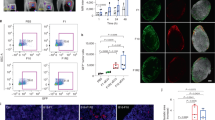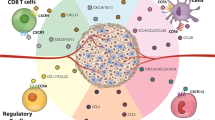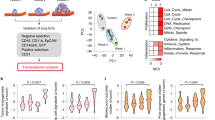Abstract
The mechanisms that cause tumors such as melanomas to metastasize into peripheral lymphatic capillaries are poorly defined. Non-mutually-exclusive mechanisms are lymphatic endothelial cell (LEC) chemotaxis and proliferation in response to tumor cells (chemotaxis-lymphangiogenesis hypothesis) or LECs may secrete chemotactic agents that attract cancer cells (chemotactic metastasis hypothesis). Using migration assays, we found evidence supporting both hypotheses. Conditioned medium (CM) from metastatic malignant melanoma (MMM) cell lines attracted LEC migration, consistent with the lymphangiogenesis hypothesis. Conversely, CM from mixed endothelial cells or LECs, but not blood endothelial cells, attracted MMM cells but not non-metastatic melanoma cells, consistent with the chemotactic metastasis hypothesis. MMM cell lines expressed CCR7 receptors for the lymphatic chemokine CCL21 and CCL21 neutralizing antibodies prevented MMM chemotaxis in vitro. To test for chemotactic metastasis in vivo tumor cells were xenotransplanted into nude mice ∼1 cm from an injected LEC depot. Two different MMM grew directionally towards the LECs, whereas non-metastatic melanomas did not. These observations support the hypothesis that MMM cells grow towards regions of high LEC density owing to chemotactic LEC secretions, including CCL21. This chemotactic metastasis may contribute to the close association between metastasizing tumor cells and peri-tumor lymphatic density and promote lymphatic invasion.
This is a preview of subscription content, access via your institution
Access options
Subscribe to this journal
Receive 50 print issues and online access
$259.00 per year
only $5.18 per issue
Buy this article
- Purchase on Springer Link
- Instant access to full article PDF
Prices may be subject to local taxes which are calculated during checkout






Similar content being viewed by others
References
Achen MG, Williams RA, Minekus MP, Thornton GE, Stenvers K, Rogers PA et al. (2001). Localization of vascular endothelial growth factor-D in malignant melanoma suggests a role in tumour angiogenesis. J Pathol 193: 147–154.
Agarwal B, Saxena R, Morimiya A, Mehrotra S, Badve S . (2005). Lymphangiogenesis does not occur in breast cancer. Am J Surg Pathol 29: 1449–1455.
Akagi K, Ikeda Y, Miyazaki M, Abe T, Kinoshita J, Maehara Y et al. (2000). Vascular endothelial growth factor-C (VEGF-C) expression in human colorectal cancer tissues. Br J Cancer 83: 887–891.
Dadras SS, Paul T, Bertoncini J, Brown LF, Muzikansky A, Jackson DG et al. (2003). Tumor lymphangiogenesis: a novel prognostic indicator for cutaneous melanoma metastasis and survival. Am J Pathol 162: 1951–1960.
Elias EG, Didolkar MS, Goel IP, Formeister JF, Valenzuela LA, Pickren JL et al. (1977). A clinicopathologic study of prognostic factors in cutaneous malignant melanoma. Surg Gynecol Obstet 144: 327–334.
Gunn MD, Tangemann K, Tam C, Cyster JG, Rosen SD, Williams LT . (1998). A chemokine expressed in lymphoid high endothelial venules promotes the adhesion and chemotaxis of naive T lymphocytes. Proc Natl Acad Sci USA 95: 258–263.
Hendrix MJ, Seftor EA, Seftor RE, Fidler IJ . (1987). A simple quantitative assay for studying the invasive potential of high and low human metastatic variants. Cancer Lett 38: 137–147.
Kriehuber E, Breiteneder-Geleff S, Groeger M, Soleiman A, Schoppmann SF, Stingl G et al. (2001). Isolation and characterization of dermal lymphatic and blood endothelial cells reveal stable and functionally specialized cell lineages. J Exp Med 194: 797–808.
Lubach D, Ludemann W, Berens von Rautenfeld D . (1996). Recent findings on the angioarchitecture of the lymph vessel system of human skin. Br J Dermatol 135: 733–737.
Luther SA, Bidgol A, Hargreaves DC, Schmidt A, Xu Y, Paniyadi J et al. (2002). Differing activities of homeostatic chemokines CCL19, CCL21, and CXCL12 in lymphocyte and dendritic cell recruitment and lymphoid neogenesis. J Immunol 169: 424–433.
Mashino K, Sadanaga N, Yamaguchi H, Tanaka F, Ohta M, Shibuta K et al. (2002). Expression of chemokine receptor CCR7 is associated with lymph node metastasis of gastric carcinoma. Cancer Res 62: 2937–2941.
Muller A, Homey B, Soto H, Ge N, Catron D, Buchanan ME et al. (2001). Involvement of chemokine receptors in breast cancer metastasis. Nature 410: 50–56.
Podgrabinska S, Braun P, Velasco P, Kloos B, Pepper MS, Jackson DG et al. (2002). Molecular characterization of lymphatic endothelial cells. Proc Natl Acad Sci USA 22: 22.
Saeki H, Moore AM, Brown MJ, Hwang ST . (1999). Cutting edge: secondary lymphoid-tissue chemokine (SLC) and CC chemokine receptor 7 (CCR7) participate in the emigration pathway of mature dendritic cells from the skin to regional lymph nodes. J Immunol 162: 2472–2475.
Scandella E, Men Y, Gillessen S, Forster R, Groettrup M . (2002). Prostaglandin E2 is a key factor for CCR7 surface expression and migration of monocyte-derived dendritic cells. Blood 100: 1354–1361.
Shields JD, Borsetti M, Rigby H, Harper SJ, Mortimer PS, Levick JR et al. (2004). Lymphatic density and metastatic spread in human malignant melanoma. Br J Cancer 90: 693–700.
Sipos B, Kojima M, Tiemann K, Klapper W, Kruse ML, Kalthoff H et al. (2005). Lymphatic spread of ductal pancreatic adenocarcinoma is independent of lymphangiogenesis. J Pathol 207: 301–312.
Skobe M, Hawighorst T, Jackson DG, Prevo R, Janes L, Velasco P et al. (2001). Induction of tumor lymphangiogenesis by VEGF-C promotes breast cancer metastasis. Nat Med 7: 192–198.
Stacker SA, Caesar C, Baldwin ME, Thornton GE, Williams RA, Prevo R et al. (2001). VEGF-D promotes the metastatic spread of tumor cells via the lymphatics. Nat Med 7: 186–191.
Stanton AW, Kadoo P, Mortimer PS, Levick JR . (1997). Quantification of the initial lymphatic network in normal human forearm skin using fluorescence microlymphography and stereological methods. Microvasc Res 54: 156–163.
Stanton AW, Patel HS, Levick JR, Mortimer PS . (1999). Increased dermal lymphatic density in the human leg compared with the forearm. Microvasc Res 57: 320–328.
Takanami I . (2003). Overexpression of CCR7 mRNA in non-small cell lung cancer: correlation with lymph node metastasis. Int J Cancer 105: 186–189.
Takeuchi H, Fujimoto A, Tanaka M, Yamano T, Hsueh E, Hoon DS . (2004). CCL21 chemokine regulates chemokine receptor CCR7 bearing malignant melanoma cells. Clin Cancer Res 10: 2351–2358.
Wagner JD, Gordon MS, Chuang TY, Coleman III JJ . (2000). Current therapy of cutaneous melanoma. Plast Reconstr Surg 105: 1774–1799.
Wang J, Xi L, Hunt JL, Gooding W, Whiteside TL, Chen Z et al. (2004). Expression pattern of chemokine receptor 6 (CCR6) and CCR7 in squamous cell carcinoma of the head and neck identifies a novel metastatic phenotype. Cancer Res 64: 1861–1866.
White RR, Stanley WE, Johnson JL, Tyler DS, Seigler HF . (2002). Long-term survival in 2,505 patients with melanoma with regional lymph node metastasis. Ann Surg 235: 879–887.
Wiley HE, Gonzalez EB, Maki W, Wu Mt MT, Hwang ST . (2001). Expression of CC chemokine receptor-7 and regional lymph node metastasis of B16 murine melanoma. J Natl Cancer Inst 93: 1638–1643.
Yan C, Zhu ZG, Yu YY, Ji J, Zhang Y, Ji YB et al. (2004). Expression of vascular endothelial growth factor C and chemokine receptor CCR7 in gastric carcinoma and their values in predicting lymph node metastasis. World J Gastroenterol 10: 783–790.
Acknowledgements
We acknowledge the kind gift of VEGF-C from Kari Alitalo, the LYVE-1 antibody from David Jackson, A375P cells from IJ Fidler, some LEC cells from Carolyn Yong and Melody Swartz and the technical help of Mr Sam Baldwin. This research was supported by the Wellcome Trust (66011 and 62951), the British Heart Foundation (BB2000003), the Skin Cancer Research Fund (ScaRF), the Luff Fund and the Healing Foundation.
Author information
Authors and Affiliations
Corresponding author
Additional information
Supplementary Information accompanies the paper on the Oncogene website (http://www.nature.com/onc).
Supplementary information
Rights and permissions
About this article
Cite this article
Shields, J., Emmett, M., Dunn, D. et al. Chemokine-mediated migration of melanoma cells towards lymphatics – a mechanism contributing to metastasis. Oncogene 26, 2997–3005 (2007). https://doi.org/10.1038/sj.onc.1210114
Received:
Revised:
Accepted:
Published:
Issue Date:
DOI: https://doi.org/10.1038/sj.onc.1210114
Keywords
This article is cited by
-
Rethinking the biology of metastatic melanoma: a holistic approach
Cancer and Metastasis Reviews (2021)
-
Biophysical interactions between components of the tumor microenvironment promote metastasis
Biophysical Reviews (2021)
-
Docetaxel facilitates lymphatic-tumor crosstalk to promote lymphangiogenesis and cancer progression
BMC Cancer (2018)
-
Tissue-engineered 3D melanoma model with blood and lymphatic capillaries for drug development
Scientific Reports (2018)
-
Expression of CCL21 in Ewing sarcoma shows an inverse correlation with metastases and is a candidate target for immunotherapy
Cancer Immunology, Immunotherapy (2016)



